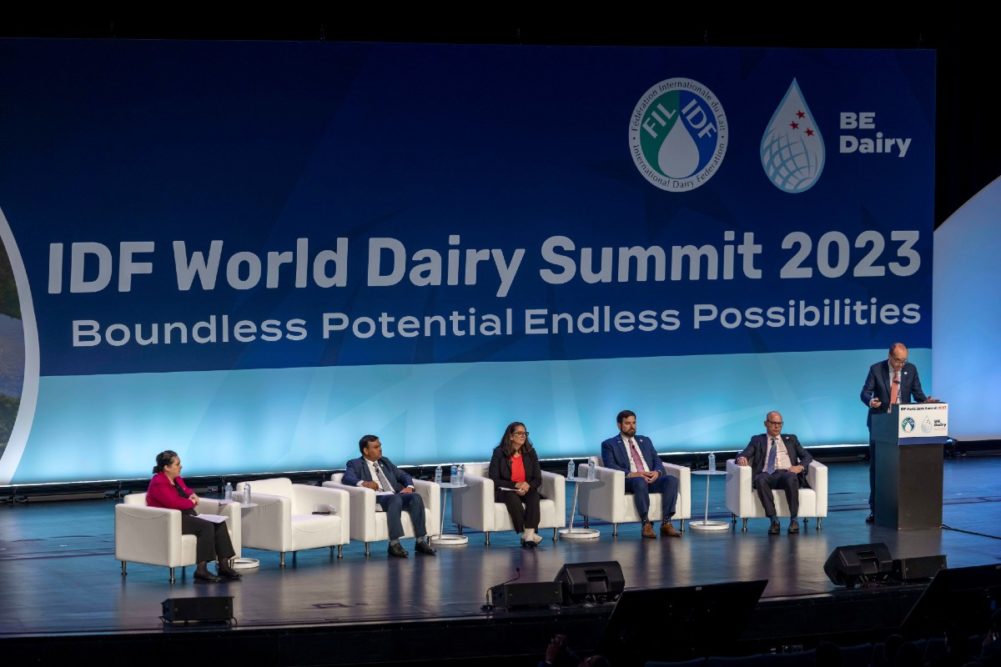CHICAGO – “Do not think of yourself as a commodity, but rather a product that is essential to everyone’s life all around the world,” said Jeff McCrory, chief strategic officer with Mischief, a marketing agency based in New York, during the International Dairy Federation (IDF) World Dairy Summit held Oct. 16-19.
The summit’s theme – BE Dairy: Boundless Potential. Endless Possibilities — reflected the content that focused on developments in dairy science, technology, knowledge and innovation from all over the world.
To “BE Dairy,” one must start by embracing the fact that the dairy industry is critical to feeding the world, according to Nicholas Gardner, senior vice president, sustainability and multilateral affairs, US Dairy Export Council, Arlington, Va., who cited data from the Food and Agriculture Organization of the United Nations.
“Three billion people, that’s 37% of every man, woman and child, cannot afford a healthy, nutritionally adequate diet,” Gardner said. “We nourish billions of people every day.”
IDF president Piercristiano Brazzale said, “We must be proud of that.”
“We must continue to encourage consumption of milk and dairy products while investing in production innovation,” Brazzale said. “And we must further the dairy sector’s ongoing efforts and positive potential to improve sustainability in a holistic manner by taking context-specific steps to reduce greenhouse gas emissions, preserve water quality, decrease water use, champion soil health, save energy, produce renewable energy resources and develop packaging and recyclability technologies that reduce waste.”
These efforts come from all sectors, sometimes even unlikely players. Since 2021, Starbucks Corp., Seattle, for example, has been collaborating with dairy farmers to help refine and scale an approach to sustainable dairy and environmental stewardship for the betterment of people, the planet and animals.
Starbucks served its first latte in 1984, according to Angela Anderson, director, sustainable dairy, at Starbucks. It was made with whole milk, and since, cow’s milk has been an integral ingredient for the company. While Starbucks will continue to expand its plant-based options — in order to have something for everyone -- dairy is part of more than half of Starbucks’ core beverage offerings.
“In the US last year, 79% of all ‘milk’ used in Starbucks was from cows,” Anderson said. “We’re not getting away from dairy. We are committed to dairy.”
To emphasize the company’s commitment, she cited how the Impossible breakfast sandwich includes real cheddar cheese. And most baked goods sold at the coffeehouses are made with butter.
“You would be surprised how many customers order an oat latte with real dairy whipped cream,” she said.
This collaboration with dairy farmers is all about giving more than taking from the planet, according to Anderson. She explained that dairy is the biggest contributor to Starbucks’ carbon footprint and the second highest contributor to water withdrawal. The company believes it is its responsibility to help drive solutions that support both people and the planet.
“We know farmers have long been on the sustainability journey,” Anderson said. “But we do need verification of what the farmers are doing.”
Said Marilyn Hershey, a Pennsylvania dairy farmer and chair of Dairy Management Inc., Rosemont, Ill.: “Every farm has its own story to tell. The solutions on my farm are different than the solutions elsewhere.”
Hershey explained how her family-owned farm prioritizes environmental stewardship. They have implemented a series of best practices to protect the soil, reduce water consumption and minimize the carbon footprint of their operations. In 2017, the farm installed a methane digester, taking manure from the cows and converting it to electricity. The farm also is able to incorporate food waste from the local community, increasing the amount of gas produced from the methane digester. The digester produces enough gas to run the farm, as well as contribute to the community. This generation of renewable energy reduces methane emissions, one of the most potent greenhouse gases responsible for climate change.
“I pay a great deal of attention to the calves, taking care of them almost like a mother,” Hershey said. “Thanks to that passion and dedication, we produce a top-quality product that is nutritious and provides value for consumers. We take great pride in this.”
The global dairy industry also provides jobs and valuable revenues and resources for communities, according to Brazzale, who explained that there are more than 600 million people living on approximately 133 million dairy farms around the world.
“Farms employ 240 million people across diverse cultures worldwide directly or indirectly in a dairy sector that feeds more than 80% of the world’s population who regularly consume milk and dairy products,” Brazzale said.
Caroline Emond, director general for IDF, concluded the summit by saying, “Mother Nature is doing a pretty good job with dairy. Milk is perfection. There are endless possibilities. Let’s showcase what we can do.”

